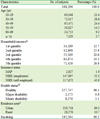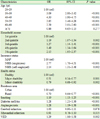1. Pihlstrom BL, Michalowicz BS, Johnson NW. Periodontal diseases. Lancet. 2005; 366:1809–1820.

2. Highfield J. Diagnosis and classification of periodontal disease. Aust Dent J. 2009; 54:Suppl 1. S11–S26.

3. Page RC, Eke PI. Case definitions for use in population-based surveillance of periodontitis. J Periodontol. 2007; 78:1387–1399.

4. NIH Consensus Conference. Impotence. NIH Consensus Development Panel on Impotence. JAMA. 1993; 270:83–90.

5. Feldman HA, Goldstein I, Hatzichristou DG, Krane RJ, McKinlay JB. Impotence and its medical and psychosocial correlates: results of the Massachusetts Male Aging Study. J Urol. 1994; 151:54–61.

6. Selvin E, Burnett AL, Platz EA. Prevalence and risk factors for erectile dysfunction in the US. Am J Med. 2007; 120:151–157.

7. Cho YJ, Hwang HS, Park HK, Jeong JG. Prevalence of erectile dysfunction and utilization of sexual counseling in community family medicine clinics. Korean J Fam Med. 2009; 30:617–625.

8. Aversa A, Bruzziches R, Francomano D, Natali M, Gareri P, Spera G. Endothelial dysfunction and erectile dysfunction in the aging man. Int J Urol. 2010; 17:38–47.

9. Sanz M, D'Aiuto F, Deanfield J, Fernandez-Avilés F. European workshop in periodontal health and cardiovascular disease-scientific evidence on the association between periodontal and cardiovascular diseases: a review of the literature. Eur Heart J Suppl. 2010; 12:B3–B12.

10. Keller JJ, Chung SD, Lin HC. A nationwide population-based study on the association between chronic periodontitis and erectile dysfunction. J Clin Periodontol. 2012; 39:507–512.

11. Lee JH, Lee JS, Park JY, Choi JK, Kim DW, Kim YT, et al. Association of lifestyle-related comorbidities with periodontitis: a nationwide cohort study in Korea. Medicine (Baltimore). 2015; 94:e1567.

12. Gil-Montoya JA, de Mello AL, Barrios R, Gonzalez-Moles MA, Bravo M. Oral health in the elderly patient and its impact on general well-being: a nonsystematic review. Clin Interv Aging. 2015; 10:461–467.

13. Lee JH, Lee JS, Choi JK, Kweon HI, Kim YT, Choi SH. National dental policies and socio-demographic factors affecting changes in the incidence of periodontal treatments in Korean: a nationwide population-based retrospective cohort study from 2002–2013. BMC Oral Health. 2016; 16:118.

14. Eke PI, Dye BA, Wei L, Slade GD, Thornton-Evans GO, Beck JD, et al. Self-reported measures for surveillance of periodontitis. J Dent Res. 2013; 92:1041–1047.

15. Zhang B, Khalaf H, Sirsjö A, Bengtsson T. Gingipains from the periodontal pathogen
Porphyromonas gingivalis play a significant role in regulation of angiopoietin 1 and angiopoietin 2 in human aortic smooth muscle cells. Infect Immun. 2015; 83:4256–4265.

16. Albandar JM. Epidemiology and risk factors of periodontal diseases. Dent Clin North Am. 2005; 49:517–532. v–vi.

17. Zambon JP, Mendonça RR, Wroclawski ML, Karam Junior A, Santos RD, Carvalho JA, et al. Cardiovascular and metabolic syndrome risk among men with and without erectile dysfunction: case-control study. Sao Paulo Med J. 2010; 128:137–140.

18. Ioakeimidis N, Vlachopoulos C, Rokkas K, Aggelis A, Terentes-Printzios D, Samentzas A, et al. Relationship of asymmetric dimethylarginine with penile Doppler ultrasound parameters in men with vasculogenic erectile dysfunction. Eur Urol. 2011; 59:948–955.

19. Schaefer AS, Richter GM, Groessner-Schreiber B, Noack B, Nothnagel M, El Mokhtari NE, et al. Identification of a shared genetic susceptibility locus for coronary heart disease and periodontitis. PLoS Genet. 2009; 5:e1000378.
20. Oğuz F, Eltas A, Beytur A, Akdemir E, Uslu MO, Güneş A. Is there a relationship between chronic periodontitis and erectile dysfunction? J Sex Med. 2013; 10:838–843.
21. Sharma A, Pradeep AR, Raju PA. Association between chronic periodontitis and vasculogenic erectile dysfunction. J Periodontol. 2011; 82:1665–1669.

22. Stewart R, West M. Increasing evidence for an association between periodontitis and cardiovascular disease. Circulation. 2016; 133:549–551.

23. Tonetti MS, D’Aiuto F, Nibali L, Donald A, Storry C, Parkar M, et al. Treatment of periodontitis and endothelial function. N Engl J Med. 2007; 356:911–920.

24. Martínez-Maestre MA, González-Cejudo C, Machuca G, Torrejón R, Castelo-Branco C. Periodontitis and osteoporosis: a systematic review. Climacteric. 2010; 13:523–529.

25. Subramanian S, Emami H, Vucic E, Singh P, Vijayakumar J, Fifer KM, et al. High-dose atorvastatin reduces periodontal inflammation: a novel pleiotropic effect of statins. J Am Coll Cardiol. 2013; 62:2382–2391.

26. Chou CY, Yang YF, Chou YJ, Hu HY, Huang N. Statin use and incident erectile dysfunction--a nationwide propensity-matched cohort study in Taiwan. Int J Cardiol. 2016; 202:883–888.

27. Zuo Z, Jiang J, Jiang R, Chen F, Liu J, Yang H, et al. Effect of periodontitis on erectile function and its possible mechanism. J Sex Med. 2011; 8:2598–2605.
28. Vlachopoulos C, Rokkas K, Ioakeimidis N, Stefanadis C. Inflammation, metabolic syndrome, erectile dysfunction, and coronary artery disease: common links. Eur Urol. 2007; 52:1590–1600.
29. Esper RJ, Nordaby RA, Vilariño JO, Paragano A, Cacharrón JL, Machado RA. Endothelial dysfunction: a comprehensive appraisal. Cardiovasc Diabetol. 2006; 5:4.

30. Holtfreter B, Schwahn C, Biffar R, Kocher T. Epidemiology of periodontal diseases in the study of health in pomerania. J Clin Periodontol. 2009; 36:114–123.








 PDF
PDF ePub
ePub Citation
Citation Print
Print





 XML Download
XML Download